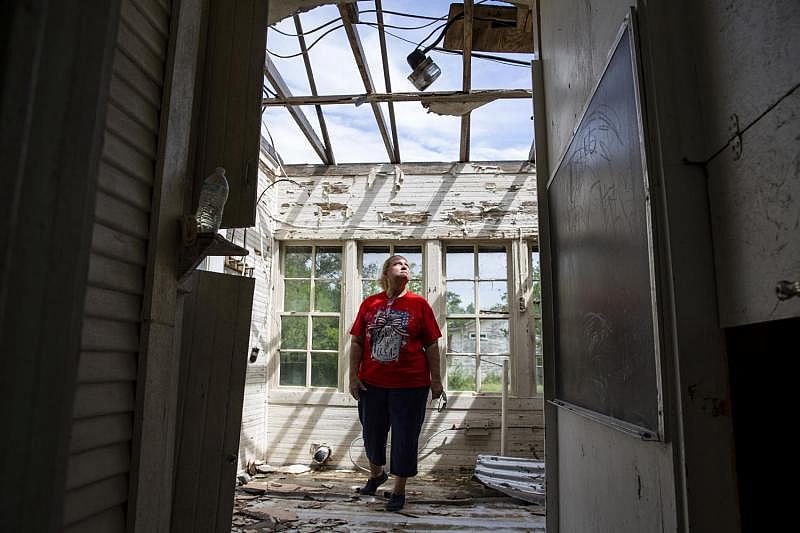PART 4: Will small towns recover after Harvey? It's a matter of if, not when
This project was produced with the support of USC Center for Health Journalism’s National Fellowship and Report for America, which deploys emerging journalists in local newsrooms like the Victoria Advocate.
Other stories in this series include:
Christmas miracle arrives for family struggling to rebuild after Harvey
11 years have passed since affordable housing was built in Victoria; advocates say change needed
Part 3: Mold, bedbugs, rising rents — the reality of renting post-Harvey
Part 2: 'Willful blindness:' After Harvey, a Victoria family feels forgotten
Volunteers help Vietnam veteran living in car after Harvey
More than one year after Harvey, Vietnam veteran still living in his car
Hurricane Harvey exposed the gap between people who could afford to rebuild — and everyone else
Rebuilding after Harvey: 'You have to build their lives — not just their homes'
Reporter column: We listened to your stories about life after Harvey. Now it's your turn to act.
'We just got so much work to do': Number of homeless outside of shelters triples in Victoria
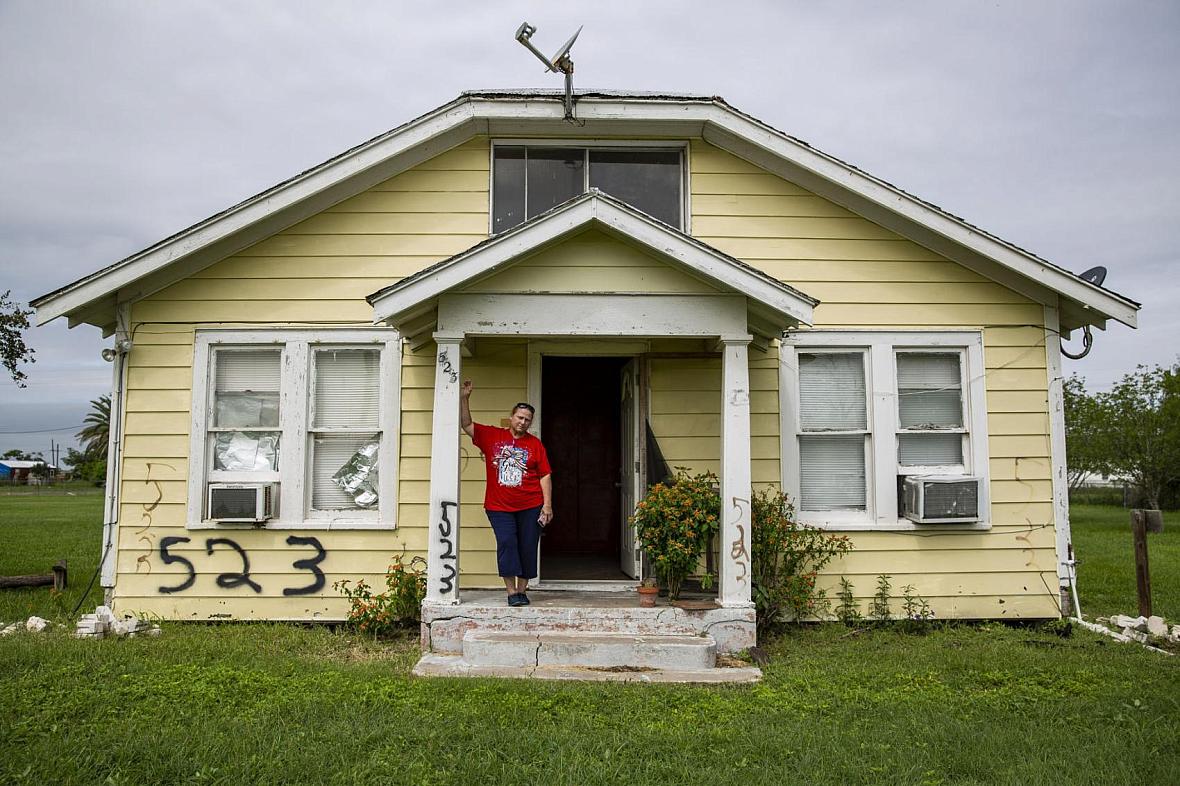
Sabine Wiegand, 55, leans against her abandoned home on 2nd Street in Bayside. Her mother, Patricia Wiegand; daughter; and grandchildren lived there before Hurricane Harvey tore off the roof and toppled a tree onto it. Sabine now lives in Portland with her daughter and grandchildren. Patricia moved to Kenedy to live with another daughter indefinitely. With the few amenities the city once had now gone, along with a large chunk of its population, Bayside is struggling to keep from disappearing entirely.
(Photo Credit: Angela Piazza/Victoria Advocate)
“You like videos?” asks Robert Blaschke, as he sits behind a large desk at thecourthouse in Refugio, a once-booming oil and ranching county home to 7,300 people.
Blaschke, a former DuPont employee who has lived in the county for all 65 years of his life, is the top elected official there, where Hurricane Harvey damaged or destroyed at least 58 percent of the housing stock. While sipping a cup of coffee, he searches his phone for a YouTube video of a Weather Channel anchor forecasting Harvey’s path hours before it slammed Texas.
He presses play. The weatherman predicts where Harvey will make landfall: “The only slice of good news in this entire thing is between Corpus Christi here and between Port O’Connor and Port Lavaca up in here, this is a very unpopulated part of the Texas coast.”
An empty lot is all that is left of Bayside's only restaurant Crofutt's. Hurricane Harvey destroyed the popular sandwich shop and bakery. (Photo Credit: Angela Piazza/Victoria Advocate)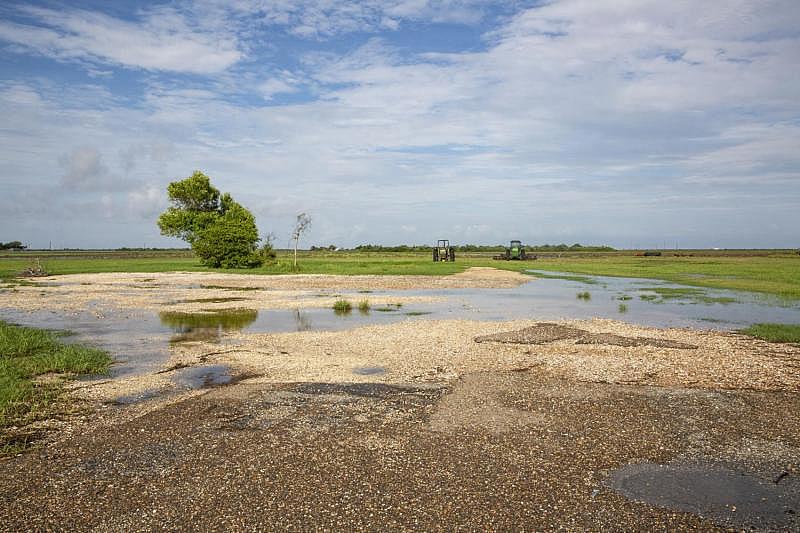
A map flashes on screen. Harvey is barreling toward Refugio County. “If this storm comes ashore here … that’s the best possible thing,” the weatherman continues.
Blaschke pauses the video.
“Fantastic!” he says sarcastically. “You got a national weather station that says, ‘Thank goodness, it’s going there – there’s nobody there.’”
To outsiders, that’s what Refugio County might seem like – a sparsely populated sprawl of cotton fields, pastures for grazing cattle, marshland and the occasional small town. But for the people who live there, the weatherman’s comments couldn’t have been more out of touch. Besides causing at least $125 million in damage across Texas, Harvey destroyed the only homes that many Refugio residents have ever known. In the aftermath, they spent sleepless nights and long, sweaty days helping their neighbors rebuild.
The Rev. Bill Lindsey preaches to a small congregation of about 20 at First Baptist Church. Before Hurricane Harvey, the modest church had around 35 parishioners. It is the only operational place of worship in town after Harvey's devastation. (Photo Credit: Angela Piazza/Victoria Advocate)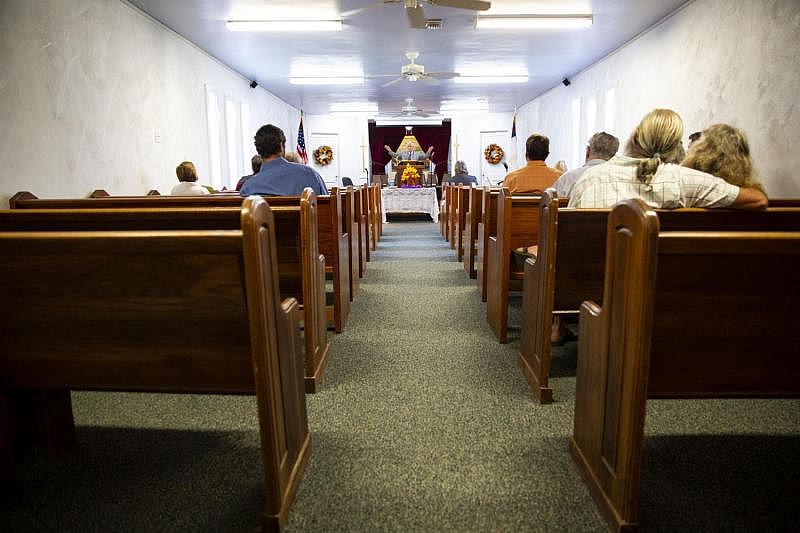
But recovery in rural areas and small towns like Tivoli, Bayside and Austwell is vastly different from cities like Houston, where public and private funding flooded the city as quickly as Harvey’s rains did. Even without the complications of a Category 4 hurricane, many of America’s small towns are slowly vanishing, their populations bleeding out into cities with more job, social service and housing options.
Before Harvey slammed these tiny Texas towns, they already were experiencing existential crises. Populations, which weren’t more than a few hundred people to begin with, dwindled in recent decades. So, too, did tax revenue.
Then Harvey ripped apart the few businesses and homes that did exist. And small towns often lack the disaster recovery expertise and political connections needed to tap into private and public funding – resources necessary to rebuild.
“They were relatively unconnected to good resources before Harvey,” explained Shannon Van Zandt, a professor of urban planning at Texas A&M University. “So now they don’t have folks to call on.”
In recent decades, more and more Texans have migrated to urban areas, leaving a little more than 15 percent of the state’s residents in rural regions, according to census estimates. In tiny towns and undeveloped swaths of land, people are more likely to be older and disabled. And when people own less, their governments often collect less taxes.
After Harvey, it’s not a matter of when those places will rebuild.
It’s a matter of if.
If the towns ever will regain the populations and businesses they lost.
If the children born into those communities will stay after they grow up despite the absence of educational and job opportunities.
If the towns will recover in Harvey’s wake.
More than one year after Harvey struck, it’s clear that the weatherman in the YouTube video wasn’t the only outsider to overlook Refugio County. The community rarely made national headlines. Volunteers were slow to arrive.
Even today, “forgotten” is a word often uttered by residents and county officials when talking about recovery there.
“I don’t want to be critical of our leaders, but Gov. Greg Abbott didn’t get here until October the 9th,” Blaschke continued. In contrast, Abbott and Vice President Mike Pence toured Rockport just six days after Harvey made landfall there, less than 15 miles across the bay from Refugio County.
But the economy in Refugio County already was spiraling downward before Harvey. Since 2000, the county’s labor force shrank by about 16 percent, according to state data. Populations in the towns dropped anywhere from 20 to 35 percent in recent decades, the effect of a steady exodus as oil production dwindled. That further complicates the fact that in the past five years, the county lost more than $400 million in taxable property. Local governments barely have enough staff for daily operations without cuts – let alone extra staff to navigate complicated grant applications for money to rebuild.
“The economies were already somewhat fragile in these communities,” Blaschke said. “So then Harvey just exacerbates that.”
A house on West Street in Bayside is missing sections of roof and wall. The windows are broken, and vegetation grows over trash inside. (Photo Credit: Angela Piazza/Victoria Advocate)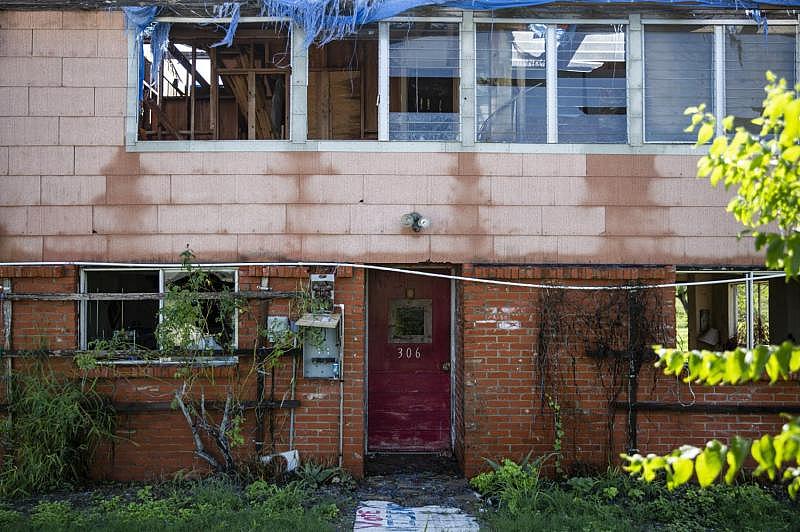
During the year after Harvey, the value of taxable property in Refugio County dropped by $23 million. But the community’s leaders aren’t giving up yet. Even before the hurricane, county officials were searching for ways to make places like Bayside and Austwell competitive with larger counterparts. Those tiny towns, officials hope, could become the next bedroom communities for the Coastal Bend, a region along the Texas Gulf Coast that’s expected to grow exponentially because of rising oil production. Refugio’s neighboring county, San Patricio, for example, is expecting billions of dollars in economic growth, including a $9.3 billion ExxonMobil plant and a $1 billion steel pipe manufacturing facility.
“There is a new horizon for those communities,” explained Ray De Los Santos Jr., who runs a planning firm in Corpus Christi that was hired to work in Refugio. “And even in the midst of something as catastrophic as Hurricane Harvey, there is opportunity for growth.”
At a minimum, local officials hope they can hold off population decline. At best, those trends could be reversed. To move in that direction, Refugio’s community development foundation commissioned De Los Santos’ group to develop plans for the county’s small towns, created by holding public talks and surveying residents.
In Bayside, for example, De Los Santos found that residents’ top priorities were installing street lights to illuminate pitch-black roads, upgrading city parks and expanding sewer service to areas lacking it. City officials will be tasked with taking steps to accomplish those goals.
De Los Santos’ team is also producing formal retail and housing surveys to detail what sorts of development communities need. For example, the reports could show whether towns could support developments like apartments, restaurants, grocery stores or gas stations. That information can then be used to attract developers – instead of losing their business to larger cities that might otherwise appear more profitable.
A gaping hole in the side of Bayside’s old grocery store building reveals abandoned antiques and other items. Residents say many years ago, it was one of two stores in town. Now, the nearest grocery store is about 17 miles away. (Photo Credit: Angela Piazza/Victoria Advocate)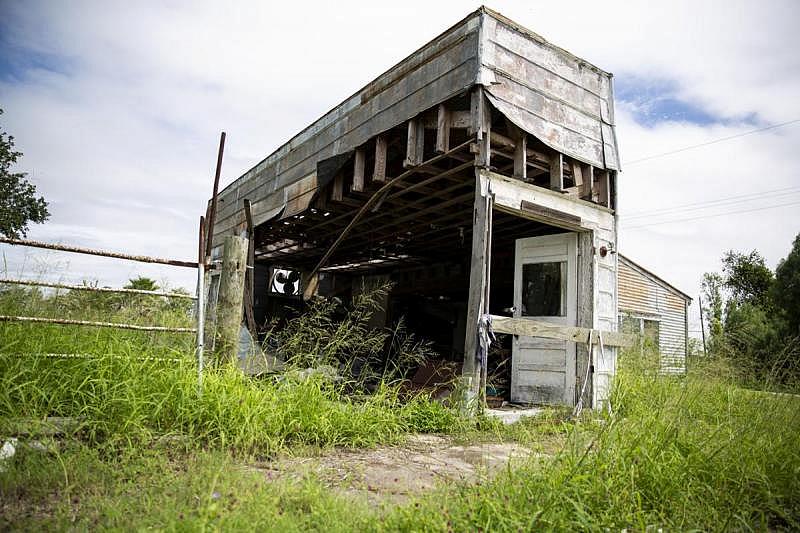
“We’re just trying to level the playing field a little bit,” he said. “We want that report to be a tool to recruit those builders, developers and investors to fill those gaps.”
But even with all the talk of growth, some residents, especially working families and those with lower incomes, feel they’re being left behind. Some go as far as saying that their governments and wealthier neighbors are trying to push them out in an attempt to make way for wealthier homeowners and increased property values.
In the town of Refugio, for example, Manny Govella was arrested over the summer when he slept through court dates after he was fined for leaving Harvey’s debris outside his yard. The 66-year-old said he doesn’t drive because of health problems, meaning he couldn’t haul off the brush. Even if he could drive, his Social Security income isn’t enough to cover the fees at the dump, he said.
“It’s embarrassing,” Govella said. “I know if I was selling drugs or if I had shot or beat somebody – but getting arrested for having a pile of limbs by the side of the road?”
A faded, shredded American flag is wrapped around a tree in front of a waterfront property on Copano Bay Drive from which a family fled after Harvey damaged it. A newly built house towers over the home. (Photo Credit: Angela Piazza/Victoria Advocate)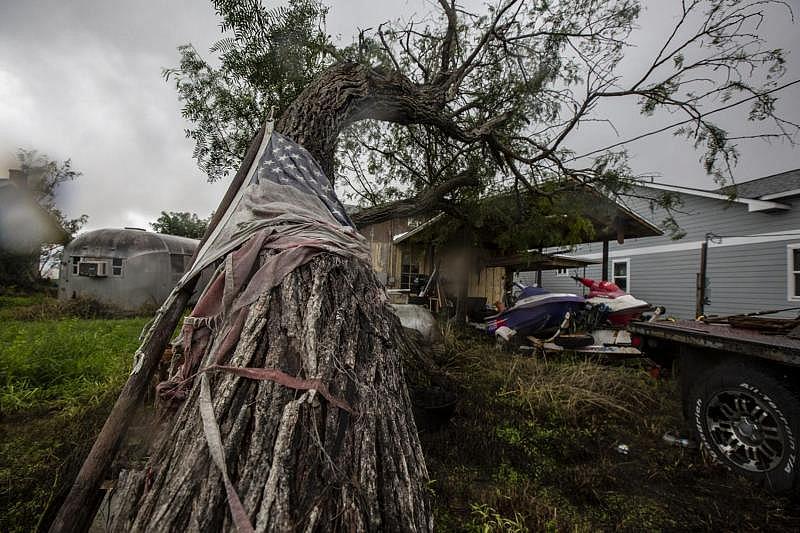
Refugio officials said the town was simply trying to get the community cleaned up, and the action was in no way meant to make money or penalize homeowners. But other nearby officials were skeptical.
“You want us to send them a fine on top of their hardship?” asked Mary Canales, who was raised in Austwell and now serves as the mayor there. “That’s so wrong.”
Austwell is a town of fewer than 150 people on Hynes Bay, where there are no restaurants, grocery stores or gas stations. The town runs on about $70,000 per year. In Harvey’s aftermath, Canales wanted to stop families from leaving, so she refused to condemn any homes despite some of her neighbors’ protests. At one point, a neighbor threatened to sue the city if it allowed one woman to replace her destroyed trailer with a single-wide mobile home.
“Some even claim that a piece of her trailer house ruined their roof,” Canales explained. “There was stuff blowing everywhere; did it have her name on it? I think not.”
In the end, the woman brought a trailer home into Austwell. But people in Bayside, a sleepy fishing and farming town of 325 people nestled on the Copano Bay, weren’t so lucky. Although town officials estimated it lost anywhere from 30 to 50 homes, they wouldn’t waive a law banning single-wide mobile homes.
Some officials argued that allowing single-wides would create financial problems in the future because the city wouldn’t bring in as much property tax revenue. Residents, however, said it was an attempt by those in power to change communities to favor wealthier homeowners and tourists rather than working families who might not be able to afford larger double-wide mobile homes.
“This is not Dallas, this is not Houston,” said Jorge Arzola, who was raised in Bayside. “This is a rinky-dink town.”


